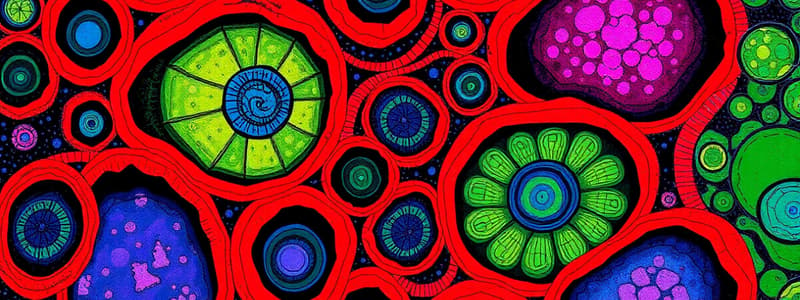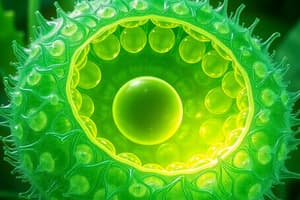Podcast
Questions and Answers
What is the main function of the cell wall in plant cells?
What is the main function of the cell wall in plant cells?
- To store genetic material and regulate gene expression
- To transport nutrients and wastes throughout the plant
- To provide structural support and maintain the plant cell's shape (correct)
- To produce energy for cellular processes
Which of the following structures glues adjacent plant cells together?
Which of the following structures glues adjacent plant cells together?
- Secondary cell wall
- Primary cell wall
- Plasmodesmata
- Middle lamella (correct)
What is the primary component of the cell wall in plants?
What is the primary component of the cell wall in plants?
- Cellulose (correct)
- Chitin
- Peptidoglycan
- Collagen
Which of these is NOT a function of the cell wall in plants?
Which of these is NOT a function of the cell wall in plants?
How does a secondary cell wall differ from a primary cell wall in plant cells?
How does a secondary cell wall differ from a primary cell wall in plant cells?
What is the main component of the extracellular matrix (ECM) in animal cells?
What is the main component of the extracellular matrix (ECM) in animal cells?
Which of the following is a key difference between the cell walls of plants and the extracellular matrix (ECM) of animals?
Which of the following is a key difference between the cell walls of plants and the extracellular matrix (ECM) of animals?
What is the function of plasmodesmata in plant cells?
What is the function of plasmodesmata in plant cells?
Which of the following statements accurately describes the role of integrins in cell signaling?
Which of the following statements accurately describes the role of integrins in cell signaling?
What distinguishes plasmodesmata from other types of cell junctions?
What distinguishes plasmodesmata from other types of cell junctions?
Based on the information provided, which type of cell junction is most similar to plasmodesmata in terms of its function?
Based on the information provided, which type of cell junction is most similar to plasmodesmata in terms of its function?
What is the primary function of desmosomes in animal cells?
What is the primary function of desmosomes in animal cells?
How does the ECM influence a cell's behavior?
How does the ECM influence a cell's behavior?
Which of the following is NOT a characteristic of proteoglycans?
Which of the following is NOT a characteristic of proteoglycans?
What is the primary function of tight junctions?
What is the primary function of tight junctions?
How do integrins connect the ECM to the cytoskeleton?
How do integrins connect the ECM to the cytoskeleton?
Flashcards
Cell Wall
Cell Wall
An extracellular structure that protects and shapes plant cells.
Functions of the Cell Wall
Functions of the Cell Wall
Protects plant cells, maintains shape, prevents excessive water uptake.
Primary Cell Wall
Primary Cell Wall
The initial thin and flexible wall secreted by young plant cells.
Middle Lamella
Middle Lamella
Signup and view all the flashcards
Secondary Cell Wall
Secondary Cell Wall
Signup and view all the flashcards
Plasmodesmata
Plasmodesmata
Signup and view all the flashcards
Extracellular Matrix (ECM)
Extracellular Matrix (ECM)
Signup and view all the flashcards
Collagen
Collagen
Signup and view all the flashcards
Proteoglycan
Proteoglycan
Signup and view all the flashcards
ECM Glycoproteins
ECM Glycoproteins
Signup and view all the flashcards
Integrins
Integrins
Signup and view all the flashcards
Cytoskeleton
Cytoskeleton
Signup and view all the flashcards
Tight Junctions
Tight Junctions
Signup and view all the flashcards
Desmosomes
Desmosomes
Signup and view all the flashcards
Gap Junctions
Gap Junctions
Signup and view all the flashcards
Study Notes
Biology (1) 1501143
- Course instructor: Dr Maysoun Qutob
- Academic year: 20241
- Course offered by: Applied Science Private University
A Tour of the Cell (Part 4)
- Extracellular components and connections between cells help coordinate cellular activities.
Cell Walls of Plants
-
Plant cells have cell walls, a defining feature that differentiates them from animal cells.
-
Functions of the Cell Wall:
- Protection of the plant cell
- Maintaining the plant cell's shape
- Preventing excessive water uptake
-
Other organisms with cell walls include prokaryotes, fungi, and some unicellular eukaryotes.
-
Plant cell walls are much thicker than the plasma membrane.
-
Composition: Cellulose fibers embedded in other polysaccharides and proteins.
Formation of Cell Wall
- Young plant cells initially secrete a relatively thin, flexible primary cell wall.
- Middle lamella: Located between the primary walls of adjacent cells, composed of sticky polysaccharides (pectins).
- The middle lamella glues adjacent cells together.
- Secondary cell wall: Some plant cells strengthen their primary wall by secreting substances into it. Other plant cells form a secondary cell wall between the primary cell wall and the plasma membrane.
- Plasmodesmata: Plant cell walls are perforated by channels called plasmodesmata, which connect adjacent cells.
The Extracellular Matrix (ECM) of Animal Cells
- Animal cells have an extracellular matrix (ECM).
- Main components: Glycoproteins and other carbohydrate-containing molecules (mostly collagen).
- Collagen: forms strong fibers embedded in the ECM network.
- Proteoglycans: ECM components comprised of a core protein with many carbohydrate chains covalently attached. Proteoglycans can make up to 95% carbohydrate by weight.
- Fibronectin: A glycoprotein in the ECM that connects to specific receptor proteins (integrins) in the plasma membrane.
- Integrins: Span the cell membrane and bind to associated proteins connected to the cytoskeleton, acting as a bridge between the ECM and the cytoplasm.
Integrins
- Signal Transmission: Integrins transmit signals between the ECM and the cytoskeleton.
- Cell Behavior Regulation: ECMs can regulate cellular behavior and influence the activity of genes in the cell's nucleus.
Cell Junctions
- Neighboring cells often adhere, interact, and communicate via direct physical contact.
Plasmodesmata in Plant Cells
- Plant cell walls are perforated with plasmodesmata—channels connecting cells.
- The cytosol passes through plasmodesmata, merging the internal chemical environments of adjacent cells.
- Plasma membranes of adjacent cells line the channels of plasmodesmata.
- Water and small molecules can pass freely between cells. In some cases, certain proteins and RNA molecules can pass.
Tight Junctions, Desmosomes, and Gap Junctions in Animal Cells
-
Animal cells have three main types of cell junctions:
- Tight junctions
- Desmosomes
- Gap junctions (most similar to plasmodesmata in plants)
-
All three types are common in epithelial tissues, lining external and internal surfaces of the body.
Studying That Suits You
Use AI to generate personalized quizzes and flashcards to suit your learning preferences.




